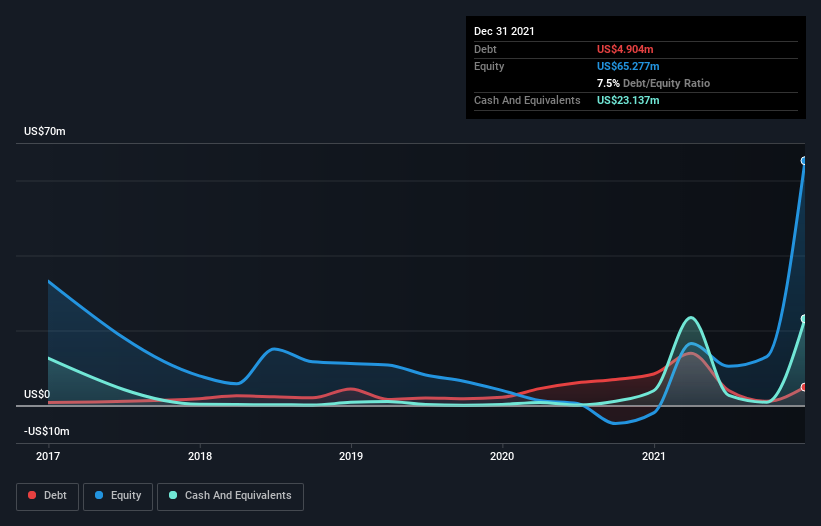Is Phunware (NASDAQ:PHUN) A Risky Investment?
David Iben put it well when he said, 'Volatility is not a risk we care about. What we care about is avoiding the permanent loss of capital.' So it might be obvious that you need to consider debt, when you think about how risky any given stock is, because too much debt can sink a company. Importantly, Phunware, Inc. (NASDAQ:PHUN) does carry debt. But the real question is whether this debt is making the company risky.
What Risk Does Debt Bring?
Debt and other liabilities become risky for a business when it cannot easily fulfill those obligations, either with free cash flow or by raising capital at an attractive price. Ultimately, if the company can't fulfill its legal obligations to repay debt, shareholders could walk away with nothing. However, a more usual (but still expensive) situation is where a company must dilute shareholders at a cheap share price simply to get debt under control. By replacing dilution, though, debt can be an extremely good tool for businesses that need capital to invest in growth at high rates of return. When we think about a company's use of debt, we first look at cash and debt together.
View our latest analysis for Phunware
What Is Phunware's Net Debt?
The image below, which you can click on for greater detail, shows that Phunware had debt of US$4.90m at the end of December 2021, a reduction from US$8.39m over a year. But on the other hand it also has US$23.1m in cash, leading to a US$18.2m net cash position.
How Healthy Is Phunware's Balance Sheet?
The latest balance sheet data shows that Phunware had liabilities of US$30.3m due within a year, and liabilities of US$3.72m falling due after that. Offsetting these obligations, it had cash of US$23.1m as well as receivables valued at US$967.0k due within 12 months. So its liabilities outweigh the sum of its cash and (near-term) receivables by US$9.91m.
Of course, Phunware has a market capitalization of US$282.7m, so these liabilities are probably manageable. Having said that, it's clear that we should continue to monitor its balance sheet, lest it change for the worse. While it does have liabilities worth noting, Phunware also has more cash than debt, so we're pretty confident it can manage its debt safely. There's no doubt that we learn most about debt from the balance sheet. But it is future earnings, more than anything, that will determine Phunware's ability to maintain a healthy balance sheet going forward. So if you want to see what the professionals think, you might find this free report on analyst profit forecasts to be interesting.
Over 12 months, Phunware reported revenue of US$11m, which is a gain of 6.4%, although it did not report any earnings before interest and tax. That rate of growth is a bit slow for our taste, but it takes all types to make a world.
So How Risky Is Phunware?
By their very nature companies that are losing money are more risky than those with a long history of profitability. And the fact is that over the last twelve months Phunware lost money at the earnings before interest and tax (EBIT) line. And over the same period it saw negative free cash outflow of US$23m and booked a US$54m accounting loss. Given it only has net cash of US$18.2m, the company may need to raise more capital if it doesn't reach break-even soon. Overall, we'd say the stock is a bit risky, and we're usually very cautious until we see positive free cash flow. There's no doubt that we learn most about debt from the balance sheet. But ultimately, every company can contain risks that exist outside of the balance sheet. To that end, you should learn about the 4 warning signs we've spotted with Phunware (including 1 which shouldn't be ignored) .
If you're interested in investing in businesses that can grow profits without the burden of debt, then check out this free list of growing businesses that have net cash on the balance sheet.
Have feedback on this article? Concerned about the content? Get in touch with us directly. Alternatively, email editorial-team (at) simplywallst.com.
This article by Simply Wall St is general in nature. We provide commentary based on historical data and analyst forecasts only using an unbiased methodology and our articles are not intended to be financial advice. It does not constitute a recommendation to buy or sell any stock, and does not take account of your objectives, or your financial situation. We aim to bring you long-term focused analysis driven by fundamental data. Note that our analysis may not factor in the latest price-sensitive company announcements or qualitative material. Simply Wall St has no position in any stocks mentioned.

